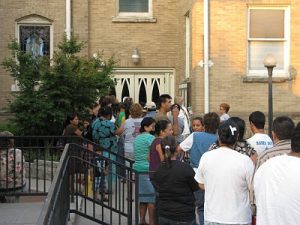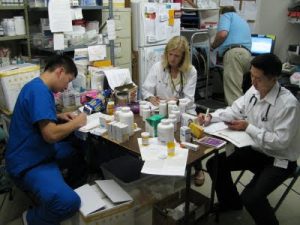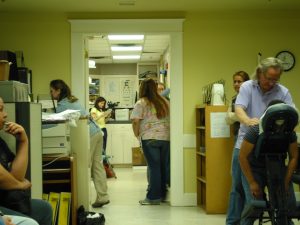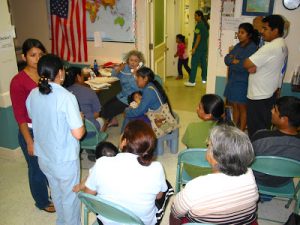Agape is the Christian concept of selfless, unconditional love. It is a three syllable word pronounced ah-GAH-peh. The Agape Clinic manifested the reality of that love beginning in the early 1980s. Photo: outreach in a community garden
From 1983-2000 I was running a “Community Care” health program (not connected to Agape) that included district health services in a refugee community and barrio, primary care provided by volunteer physicians in a po lice “storefront” and a church, and immunizations through the county health department. District health originated in the UK and to us basically meant that we took responsibility for the health of people is a defined “district” in Old East Dallas. This was under the aegis of first, Texas Woman’s University and later Baylor University School of Nursing and through cooperative relationships with other organizations such as Parkland Hospital, East Dallas Health Center, Dallas Police Department, Church Health Ministries, and other organizations. The students were central to providing all aspects of community and family and individual care. Semester after semester they did a brilliant job in the hard work of delivering quality health care and practicing loving kindness, justice and mercy in the slums.
lice “storefront” and a church, and immunizations through the county health department. District health originated in the UK and to us basically meant that we took responsibility for the health of people is a defined “district” in Old East Dallas. This was under the aegis of first, Texas Woman’s University and later Baylor University School of Nursing and through cooperative relationships with other organizations such as Parkland Hospital, East Dallas Health Center, Dallas Police Department, Church Health Ministries, and other organizations. The students were central to providing all aspects of community and family and individual care. Semester after semester they did a brilliant job in the hard work of delivering quality health care and practicing loving kindness, justice and mercy in the slums.
Leslie Kemp started working with the students and me around 1995 . Her role initially was social work and organizing the business aspects of our efforts. Photo: With Megan and Joe – outstanding students
. Her role initially was social work and organizing the business aspects of our efforts. Photo: With Megan and Joe – outstanding students
A series of circumstances led to us losing our clinic space in the fall of 2000, so in effect we were “homeless.” I talked to Dale McEowen, one of the people involved with the Agape Clinic, about sharing Agape’s space in Grace United Methodist Church. The following was written shortly after the conversation with Dale:
Dale said, “I’ve suggested several times that you come over here.” I said, “I believe you – I never heard it or I just wasn’t ready.” I remember we had all our medicine in 2-3 drawers of the big brown filing cabinet and when I told Bobbie (the clinic founder and medical director) that we’d keep ours in there she said, “no, just put it in with ours.” They had 100s of times more medications than we, so it was an extraordinarily generous thing for her to say. As he had done several times before, Martin Hironaga helped move the clinic.
When we moved into Agape I felt like we’d come home.
When we started at Agape, the clinic was open one day/week on Saturdays for primary medical care and childhood immunizations. At first our presence added a second day of services and outreach and follow-up to care. Later, we were able to further expand services. For the students and me the association with Agape meant that we had a home with far more resources and an opportunity to serve more people in more ways than previously. Phot o left: patients waiting to get in to the clinic.
o left: patients waiting to get in to the clinic.
There was good energy/ synergy between the original Agape Clinic people and the new people and resources. I started writing grant proposals – later, Leslie wrote proposals and hosted foundation visitors – and the clinic received funding from a number of foundations (Communities, Clements, Aetna, Bob Smith, First Presbyterian, Dallas Women’s Foundation, AMA Foundation, Lakewood Service League, and others), as well as churches (notably Highland Park United Methodist and First Presbyterian), and individuals. Through this wonderful energy the Agape Clinic evolved into a comprehensive community health provider with four days of services each week provided by volunteers, paid staff, and students. Services included:
- Primary care for acute illness provided by physicians, nurse practitioners
 , and medical and NP students (the foundational care from the beginning of Agape). Photo: in the pharmacy (volunteer RN/former student, nurse practitioner, physician)
, and medical and NP students (the foundational care from the beginning of Agape). Photo: in the pharmacy (volunteer RN/former student, nurse practitioner, physician) - Specialty care, including psychiatry, dermatology, gynecology, pediatrics, and asthma and immunology also provided by physicians and nurse practitioners with expertise in their respective fields.
- Treatment, teaching, and follow-up for patients with chronic illness delivered as above except teaching and follow-up were through nursing students. Among community clinics in the North Texas area, care for patients with chronic illness was unique to Agape and the follow-up (home visits for assessment and teaching) was unique among community clinics everywhere.
- Medicine provided in-house through donations, samples, and from Blessings International, a missions supply group.
- Social work provided by the Agape social worker (Leslie), promotoras (lay health promoters, primarily Lupe Springer and Nora Avila), Diane from UTA, and students in socia
 l work and nursing.
l work and nursing. - Spiritual care given by volunteer clergy, Common Grace Ministries, promotoras, and students.
- Community education provided by nursing and social work students in cooperation with promotoras.
- Health screening delivered on a daily basis in the clinic by students,and in health screening events supported by the Komen Foundation, Parkland, Dallas County Health Department, DISD, and other organizations.
- Vaccinations were for many years available on Saturdays in the Dallas area only at Agape through the work of Betty Lou Gary and her volunteer crew. Weekday vaccinations were provided by the County Health Department and students. Photo above: volunteer helping a patient with hospital bill. Photo below: The door into the exam room area. Larry, a massage therapist giving massage to a patient. He came every week.
- Special projects such as Creaciones de Fe (Creations of Faith, a support and community education group for Latin women) and the Jonathan’s Place effort, in which we provided intake physical exams and treatment of ill
 nesses for children who had been removed from their families and placed in a shelter for abused and neglected children. Creaciones ran about five years under the guidance of Lupe and the Jonathan’s Place effort lasted about 1½ years (average ~7 children/week).
nesses for children who had been removed from their families and placed in a shelter for abused and neglected children. Creaciones ran about five years under the guidance of Lupe and the Jonathan’s Place effort lasted about 1½ years (average ~7 children/week). - Immigrant health was foundational at Agape and was expanded to include refugee communities, including Middle Eastern (especially Kurds), East African, Burmese, Cambodian, and others. The Dallas County Health Department, Parkland, Baylor, and UT Arlington were central to refugee health at Agape.
- Service learning site with students from Baylor, UTSW Medical School, UTA. TWU, and others.
Paid staff included a clinic director, promotoras, and nurse practitioners. We were seriously services-oriented, strong on fundraising, and light on administration. Photo: exam.
Leslie Kemp was the original clinic social worker. Her philosophy of care was to always solve the problem and never simply refer patients elsewhere. She made home visits as needed and she also ran the front desk, inviting each person who came into the clinic to sit down next to her (vs. the patient standing in front of her desk or sitting across the desk) as she completed intake/registration, and identified problems that were not readily apparent. She always had 1-2 students working with her/learning from her in the clinic. As time passed she took on more administrative work and eventually began working as clinic director. The director position was a sacrifice for Leslie as she far preferred working directly with patients and families. She began working with foundations and writing grant proposals along with administrative work and still seeing patients. When Leslie left the clinic she left behind a lean services-oriented organization in which everyone saw patients. We had an excellent reputation in the community (among healthcare providers, foundations, other organizations, and patients and families) and a large funding surplus. Photo: Leslie on the phone, with Maria and Luvia, the translator and her baby, the patient, and in the foreground Roxanne and Lupe.
At Agape we served the uninsured, the working poor, the people who process the chicken we eat, who mow our lawns, who clean our offices and hospital rooms – we served the people who cannot get Medicaid, who cannot access services at Parkland or Project Access or Homes or anywhere else. That service is our expression of the highest love we can be – Agape.
Afterward
Reflecting on the above, one thing that stands out is the collective nature of our work. I remember Meg Kaufman, the clinic psychiatrist saying something about “this collective” and I said, yeah, that’s right. We had so many volunteers and partners, each one doing their thing toward the common good.
How did this happen? Agape was a place (and a state of mind) in which people could spread their wings. This was due, first and foremost to Bobbie Baxter, the founder and Medical D irector. She did quality work and was willing for others who did quality work to spread their wings. I was the same way. So was Leslie. We were unafraid; we were True Believers.
irector. She did quality work and was willing for others who did quality work to spread their wings. I was the same way. So was Leslie. We were unafraid; we were True Believers.
And, everything we did, we did for patients and community. And we knew what we were doing. And we abhorred meetings. As a consequence, people wanted to work there as volunteers, students, and community partners.
Following The Dream.
_______________
Volunteers included high school students, lay people from the community, college students, retirees (including WWII vets!), doctors, nurses, social workers, former patients, chaplains, and others.
Community partners I can think of are Jonathan’s Place, DISD, Dallas Police, Common Grace Ministries, Baylor University, University of Texas, Texas Woman’s University, UT Southwestern Medical School, Dallas Concilio, Highland Park UMC, HPUMC Cornerstone Congregation, Grace UMC, First Presbyterian, Dallas Women’s Foundation, Dallas County Medical Society, LabCorps, SMU, Dallas Theological Seminary, Dallas County Health Department, Parkland Hospital, and quite a few foundations and individual donors.
All working cooperatively, collectively to heal the sick.
❤️
Thank you for sharing this, Charles. The selfless work that you did in East Dallas was life changing for so many, including me and Aaron. If it were not for you and Leslie and the influence that you had first on Aaron when he was at Baylor and later on me when we returned to Dallas, I have no doubt that our lives would have taken much different turns. Thank you for your legacy and for introducing us to the refugee community in Dallas. We are so grateful.